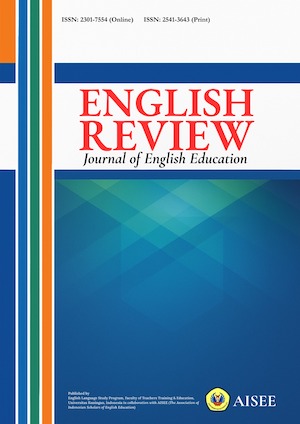IMPLEMENTATION OF ANDROID APPLICATION TO SOLVE THE STUDENTS’ PRONUNCIATION OF ENDING –ED
Abstract
This research was done because of the students’ problem of pronouncing ending –ed. To solve the problem, the researchers tried to implement the application on learning media in this gadget era. The purpose of the research is to improve the students’ problem by implementing android application in pronouncing of ending –ed and to find the factors influencing the improvement. The method of this research was qualitative method. The research design was classroom action research of second-year-students in 2018/2019 academic year at STIBA (Foreign Language College) Persada Bunda Pekanbaru. The applications used were online and offline application English Pronunciation. The result showed that there is an improvement by implementing the android application of students’ pronunciation of ending –ed. It can be seen that the increasing of the students’ ability in pronouncing of ending –ed were at the level of “fairly good” category become the level of “good” category. Some factors influencing the students’ ability in pronouncing endng –ed were they often practice and listen to the android applications whether online and offline English Pronunciation to obtain the understanding and the information how to pronounce the exact words of ending –ed. To conclude, the implementation of android application of online and android based can improve the ability of students’ pronunciation of pronouncing sound /t/, /d/, and /ɪd/ of ending –ed.References
Abbas, M. F. F., & Herdi, H. (2017). Kemampuan pengucapan kata berakhiran-ed mahasiswa semester 1 Prodi Pendidikan Bahasa Inggris FKIP-UNILAK tahun akademik 2016/2017. Lectura: Jurnal Pendidikan, 8(1).
Alan, C. (2014). Gimson’s pronunciation of English (8th ed.). London and New York: Routledge.
Anggraini, H. W., Novianti, H., & Bardadi, A. (2018). Pengembangan bahan ajar berbasis android untuk meningkatkan kemampuan pengucapan pada mahasiswa. CESS (Journal of Computer Engineering System and Science), 3(1).
Chen, H. Y., & Gowsami, J. S. (2010). The impact of phonetic and phonological instruction on the oral proficiency of Spanish-speaking ESL learners. The Asian EFL Journal, (Special Edition), 111-123.
Dale, P., & Poms, L. (2005). English pronunciation made simple. New York: Pearson Education.
Dettori, D., & Persico, D. (2011). Fostering self-regulated learning through ICT. Harshey and New York: Information Science Reference.
Erben, T., Ban, R., & Castaneda, M. (2009). Teaching English language learners through technology. New York: Routledge.
Fathira, V. (2017). Analysis of EFL students’ ability in reading vocabulary of synonyms and antonyms. Lectura, 8(1).
Goh, T. T. (2009). Multiplatform E-learning systems and technologies: Mobile devices for ubiquitous ICT-based education. Harshey and New York: Information Science Reference.
Gut, U. (2009). Introduction to English phonetics and phonology. Frankfurt: Peter Lang, International Verlag der Wissenschaften.
Kemmis, S., & McTaggart, R. (2014). The action research planner. Geelong: Deakin University Press.
Kurniawan, Y. (2008). Creative games for kids. Jakarta: Wahyu Media.
Mahmudah, L. (2015). An analysis of pronunciation exercises in duolingo application and its contribution as English learning media. (Unpublished Thesis for S1).
Ogden, R. (2009). An introduction to English phonetics. Edinburgh: Edinburgh University Press.
Rofiyarti, F., & Sari, A. Y. (2017). TIK untuk Aud: Penggunaan platform “Kahoot!” dalam menumbuhkan jiwa kompetitif dan kolaboratif anak. PEDAGOGI: Jurnal Anak Usia Dini dan Pendidikan Anak Usia Dini, 3(3b), 164-172.
Shah, S. S. A., Othman, J., & Senom, F. (2017). The pronunciation component in ESL lessons: Teachers’ beliefs and practices. Indonesian Journal of Applied Linguistics, 6(2), 193-203.
All articles published in English Review: Journal of English Education (ERJEE) are licensed under the Creative Commons Attribution 4.0 International License (CC BY 4.0).
Copyright Ownership
Authors retain the copyright of their articles and grant ERJEE the right of first publication. The journal is granted a non-exclusive license to publish, reproduce, and distribute the article in any format, medium, or platform, provided that proper credit is given to the original authors.
License Terms – CC BY 4.0
Under the Creative Commons Attribution 4.0 International License, others are free to:
- Share — copy and redistribute the material in any medium or format
- Adapt — remix, transform, and build upon the material for any purpose, even commercially
As long as they:
- Provide appropriate credit to the original author(s) and source
- Provide a link to the license (https://creativecommons.org/licenses/by/4.0/)
- Indicate if any changes were made
There are no restrictions on the reuse, reproduction, or adaptation of published articles as long as attribution is properly given.
Author Warranties
By submitting a manuscript to ERJEE, authors confirm that:
- The work is original and does not infringe any existing copyright.
- The manuscript has not been previously published and is not under consideration elsewhere.
- All sources and references are appropriately acknowledged.
- Necessary permissions have been obtained for any copyrighted materials used.









